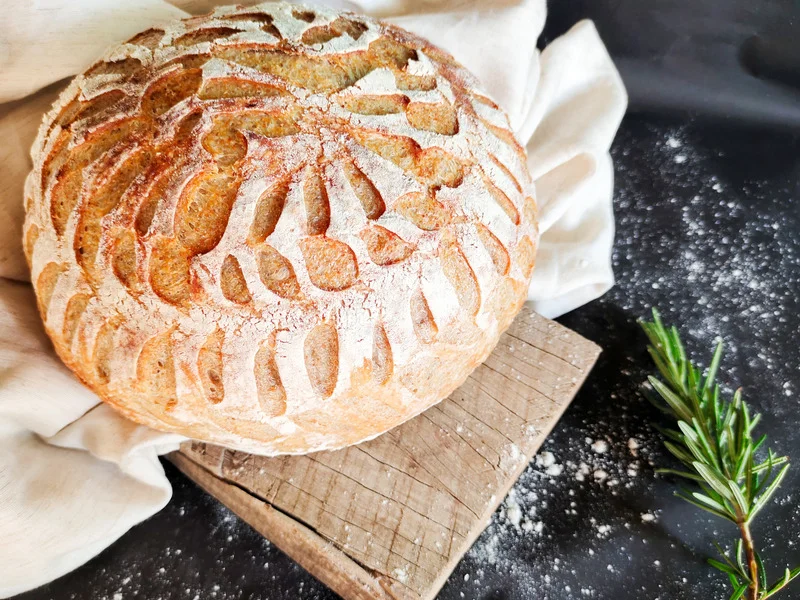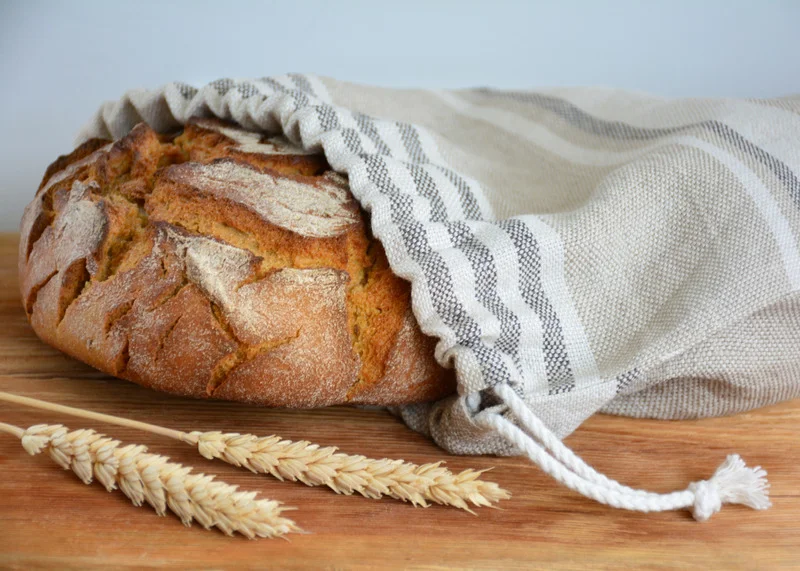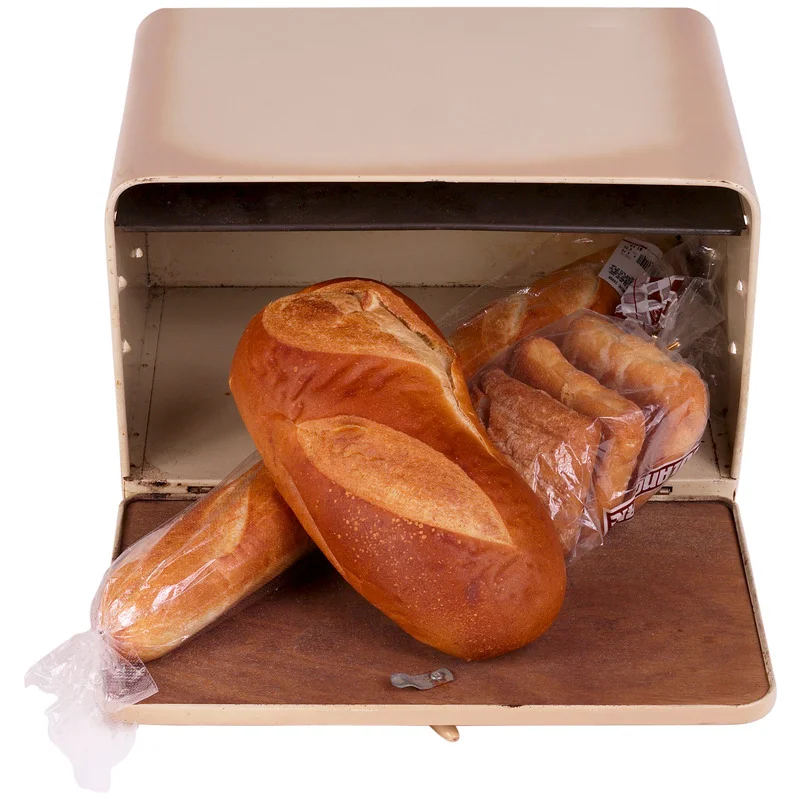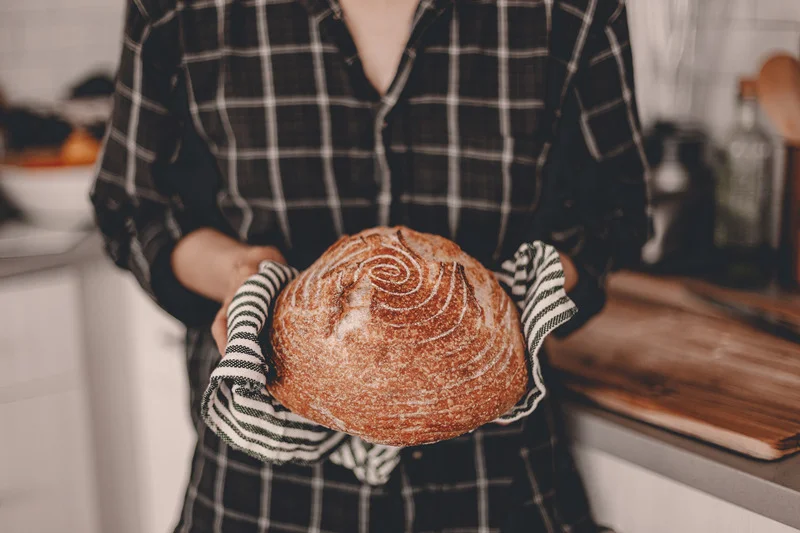You bake a gorgeous loaf of fresh sourdough bread to savor with your family, and it turns out perfectly. After slicing it and tasting the lovely fresh bread, you wonder, “Wait, how do I store the rest of this?!” As any sourdough fan knows, the real problem is keeping the loaf fresh and wonderful long after it has left the oven. Let’s get down to business and figure out how to store sourdough bread so that every slice is as delicious as the first.

How Long Does Sourdough Bread Last?
The shelf life of your sourdough bread can vary greatly based on a few important factors. Sourdough bread will keep for up to 3-5 days at a moderate room temperature of 18-20°C (64-68°F). However, without the preservatives found in many commercial loaves, sourdough’s longevity is heavily impacted by the preservation method. Sourdough is more likely to spoil as the temperature and humidity rise.
Why Does Sourdough Bread Go Bad?
Retrogradation is the specific phrase for bread ‘going bad,’ or becoming stale. During retrogradation, the starch granules that were plump and moist immediately after baking begin to cool. Moisture loss and exposure to air are the primary causes of stale and moldy sourdough. The water in the loaf travels to the surface, eventually evaporating into the air and causing the bread to “stale”. Indeed, sourdough bread can become mouldy if stored in a plastic bag or container in hot, humid circumstances with little airflow, particularly if it has not been allowed to cool properly after baking.

How to Store Fresh Sourdough Bread?
There are numerous methods for storing sourdough bread. Every way, from bread boxes to beeswax wraps, has its own pros and cons. As always, I suggest putting your freshly baked sourdough loaf in a cotton bread bag or just wrapping it in a cotton tea towel so that it can “breathe.” After that, put your bread somewhere cool so it can keep its normal moisture level and not let mold and bugs grow.
Cool The Sourdough Bread Before Slicing
Let your freshly cooked sourdough cool fully before slicing and storing. It may seem like an obvious step, but it’s crucial for the best results. You should wait at least 2 hours before cutting into your sourdough bread. At the moment the bread is removed from the oven, starch retrogradation is taking place, but it hasn’t gone far enough to solidify and set the inside properly. Slicing a warm loaf of bread too soon can yield a gooey and sticky interior.

Cut Side Down
Once you’ve sliced the sourdough, place it cut-side down on a cutting board or platter. This helps to retain moisture and prevent the all-too-familiar drying out process. The crust functions as a natural bag, retaining moisture inside and dryness outside. In humid climates, sliced bread may not last as long on the counter to prevent moulding.
Beeswax Wraps
After your bread has cooled, wrap it in a reusable beeswax wrap to keep it fresh and moist. The natural, reused, eco-friendly sheets make a thin layer that blocks some air but still lets the bread “breathe.” Just put the bread in the wrap and tighten the cover. These wraps are flexible enough to fit any loaf you want to store and keep it safe.
Linen Bread Bag
A linen bread bag is another great option for sourdough storage. Natural fibers provide just enough air circulation, regulate moisture, and keep sourdough fresh. This way, the crust will stay nice and crisp, and the crumb will stay nice and moist. It also looks beautiful and is reusable.

Aluminum Foil or Plastic Wrap
Wrapping your sourdough with aluminum foil or plastic wrap is a quick and easy alternative. You can completely cover your loaves with plastic wrap and foil while still letting air flow. However, these materials don’t allow much air movement, so use them only for short-term storage. Beeswax wrap is better for the earth, but this one isn’t quite as. These options are not reusable and may be deemed wasteful.
Bread Box
If you have room on your table, a bread box is an ideal way to store sourdough bread. It is reusable and convenient. Because it is not firmly wrapped, it allows for more air movement for the bread. These convenient containers offer the ideal microclimate to keep your bread fresh, crusty, and ready to enjoy.

A Bowl and Bowl Covers
No breadbox? No worries! Put your sourdough in a big bowl and cover with a clean kitchen towel or reusable bowl cover. The bowl retains moisture, while the cover restricts airflow. This is also better for the environment because it is reusable rather than plastic.
Paper Bags
If you plan to eat it right away, keep it in a paper bag on the counter. Most of the time, paper bread bags are used for this because they let air in, which keeps freshly baked things fresh and crusty and gives them that “just baked” taste. While paper bags are great for short-term keeping, they won’t keep the bread from drying out after a couple of days.
Kitchen Towels
To allow the bread to ‘breathe’, store it in a cotton bread bag or simply wrap it in a cotton kitchen towel. The fabric will absorb excess moisture and keep the bread from drying out. Then, store your bread in a cool spot to maintain regular moisture levels while preventing bacteria and mould growth. Just be sure to replace it if it becomes moist or musty.

How Not to Store Sourdough Bread?
In the Fridge
Sourdough does not do well when stored in the refrigerator. The frigid, dry air will absorb all of the moisture from your bread, leaving it stale and crumbly. Also, putting your freshly baked loaf of bread in the fridge will make it go bad faster than leaving it out at room temperature.
In Plastic Bags
Sealing bread completely in plastic bags can make too much wetness, which can make the crust soften and mold grow. When using plastic, make sure to leave a little opening.
Freeze Bread for Long-Term Storage
Freezing Slices
To maximize versatility, freeze your sourdough in separate slices. Put the slices in a plastic bag that can go in the freezer. Before closing the bag, take out as much air as you can. Inscribe the date on the bag, put it in the freezer, and make sure you use it within three months.

Freezing Whole Loaves
Wrap the baked bread in foil after it has cooled completely. Wrap an entire loaf of bread twice in foil before covering it with cling film or a resealable plastic bag. Place in the freezer and use within the first month or two. When you’re ready to eat, simply thaw it at room temperature and toast or broil to revive the crusty exterior.
Final Thoughts
Now you know everything you need to know of storing sourdough bread, fellow sourdough lovers. By following these clever storage tactics, you can keep your homemade loaves fresh, tasty, and ready to eat for days (or even weeks) on end. Experiment with several approaches to see what works best for your particular bread-making equipment.
So, the next time you extract a piping hot sourdough loaf from the oven, don’t squander it! Put these techniques and tricks to the test, and enjoy every last crumb guilt-free.
FAQs
So, with this in mind, I always recommend storing your freshly-baked sourdough loaf in a cotton bread bag or simply wrap it in a cotton tea towel to allow the bread to ‘breathe’. Then, leave your bread in a cool place, so it can maintain normal moisture levels without encouraging bacteria and mould to grow.
I’ll share my tips on the best way to store sourdough and a plan on the best way to eat it too. Sourdough bread will keep well for up to 3-5 days at a moderate room temperature of 18-20°C or 64-68°F. The warmer and more humid the conditions become, the more chance the sourdough has of spoiling.
To maximize the shelf life, keep in original packaging or linen based bread bag and store at room temperature. How long does sourdough bread last in the fridge? Sourdough bread should ideally not be refrigerated, as the bread will dry out and become stale faster than at room temperature.
As a general rule, avoid the fridge! fridges are way too dry and too cold and will cause your bread to get super hard super fast.
Once COMPLETELY cooled and sliced, wrap loaf well in plastic wrap and store at room temp. Vacuum sealed is also quite helpful.
FREEZER!
RE—>BAKE!
Sourdough bread will last for around 3 to 5 days if wrapped and stored correctly. But to enjoy sourdough at its best, it’s recommended to consume it within 24 hours. What is this? This way you can enjoy that crispy crust and soft, airy interior at its best.
Sources:
- The Best Way to Store Bread
- How to Store Sourdough Bread To Keep It Fresh
- How to Store Sourdough Bread
- Storing your Sourdough Loaves
- How to Keep Sourdough Bread Fresher for Longer
- How to Keep Your Sourdough Bread Fresh
- Storing your loaves
- Goodbye stale bread and How to keep bread fresh longer
- How to Store Sourdough Bread & Keep It Fresh For Longer
- How to store sourdough bread & keep it fresh
- How to store sourdough bread
- How to Store Sourdough Bread So It Stays Fresh as Long as Possible
- How to store Sourdough Bread
- The Ultimate How-To-Guide to Storing Sourdough.
- How to store sourdough bread
- 7 Genius Ways to Store Sourdough Bread
- How To Store Sourdough Bread
- How to Store a Sourdough Starter
- How to Store Sourdough Bread
- Best Ways to Store Sourdough Bread To Keep It Fresh
- How To Store and Keep Sourdough Bread Fresh
- How To Store Sourdough Bread And Keep It Fresh
- How To Store Sourdough Bread To Keep It Fresher For Longer